Mazda 3 2.0 GT Sport
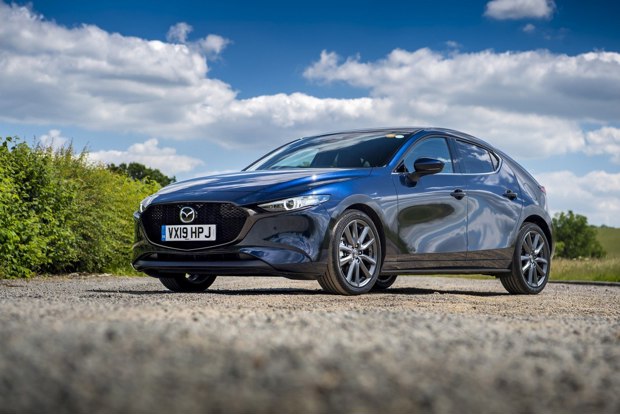
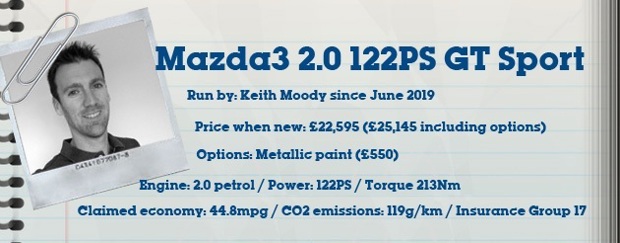
- Can the Mazda 3 match our great expectations?
- Exactly who is the Mazda 3 aimed at?
- Mazda 3 has grand designs
- Mazda 3 beset by baffling niggles
- Why doesn't the Mazda 3 have a touchscreen?
- Half-term report. How's our Mazda 3 performing?
- What's the 2019 Mazda 3 like to drive?
- Why the Mazda 3 is more comfortable than my house
- Let's talk about engines
- Which is the best Mazda 3 - saloon or hatch?
- Is the all-wheel drive system on the Mazda 3 any good?
Can the Mazda 3 match our great expectations?
New engine, new platform, new everything. Say hello to the all-new Mazda 3.

Date: 13 June 2019 | Current mileage: 475 | Claimed economy: 44.8mpg | Actual economy: 44.3mpg
There’s been a lot of hype surrounding the new Mazda 3. Many motoring publications have described its styling as ‘stunning’ and its performance as ‘brilliant’. Indeed, it's the most popular family car on HonestJohn.co.uk over the last 12 months, and we've previously rated it five stars. But, under first impressions, I'm still not convinced.
There’s no doubt this is an important car for the Japanese manufacturer. No longer is the car based on a Ford Focus, Mazda is striving out on its own to create a family hatchback to rival the best of the breed. That means high-quality interiors, all-new engines, cutting edge styling… there’s no shortage of talking points.
But, here’s the thing – we’re not really sure who it’s aimed at. It doesn’t drive better than a Focus and inside it’s very good but just not as solid-feeling as a Golf, which means it’s unlikely to poach buyers from rivals. And the aggressive styling and low-seating potion mean that Mazda’s traditionally, er, older customer base will be completely put off by it. And we haven’t even mentioned the crashy ride…
It won’t win any awards in the practicality stakes either. The boot will take two medium-suitcases but there’s not a huge amount of space in the rear seats and the sharp styling means that getting in and out of the all-new 3 is almost impossible to do without hitting your head.

Other ‘quirks’ include a low-quality Datsun-era fuel filler neck (complete with a confusing dashboard diagram about which side the fuel filler cap is or isn't on). Oh, and it has two fuel gauges, both of which display different levels. Which is novel.
So far, the thing we’ve been most impressed by is the premium 12-speaker Bose stereo system. It is really good, but whether or not that’s a dealbreaker is up to you.
There’s been a lot of complaints about the car opting for a rotary dial over a touchscreen interface. Personally, I don’t have a problem with it – but spinning the dial can get very tedious when you’re inputting destination to the satellite-navigation. You certainly wouldn’t want to head to Llanfairpwllgwyngyllgogerychwyrndrobwllllantysiliogogogoch.
Over the next six months, we’ll be putting our Mazda 3 through its paces as it tackles everything from the school run and shopping trips to family holidays, house moves and B-road blasts. Going on first impressions alone, it’s fair to say we’re not blown away by the car – but first impressions are made to be broken.
Exactly who is the Mazda 3 aimed at?
Does Mazda's traditionally older customer want really want a car with a firm ride and poor access?
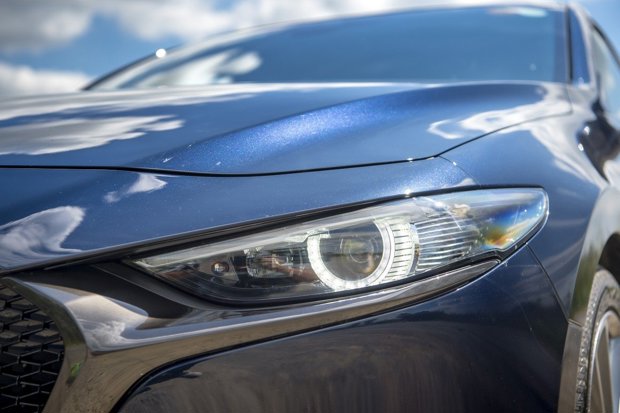
Date: 27 June 2019 | Current mileage: 1011 | Claimed economy: 44.8mpg | Actual economy: 39.3mpg
When Mazda took the wraps off the new 3, the motoring world went weak at the knees. And fair enough, the KAI concept car was pretty. Even better, most of those swooshy lines made it through to the car.
In pictures, the Mazda 3 is a very pretty car indeed – but there’s something awkward about it when you see it in the metal. It feels like a car of two halves, with its overly long bonnet and squished up hatchback rear. Let’s hope the saloon offers a more balanced design.
Our new long-termer is a 2.0-litre 122PS GT Sport costing £24,595 – although metallic paint bumps this up to £25,145. That puts it firmly in Volkswagen Golf territory if you’re looking for a family hatch so it’ll be interesting to see if Mazda can position the 3 in that market sector.
Once your inside it, it does have a nice, premium feel to it with lots of soft-touch plastics. On the go, it’s quiet too (even for a petrol) – but this could be a real stumbling block because Mazda lack of number when it comes to dealers means that it’s going to be hard getting people to sample a 3.
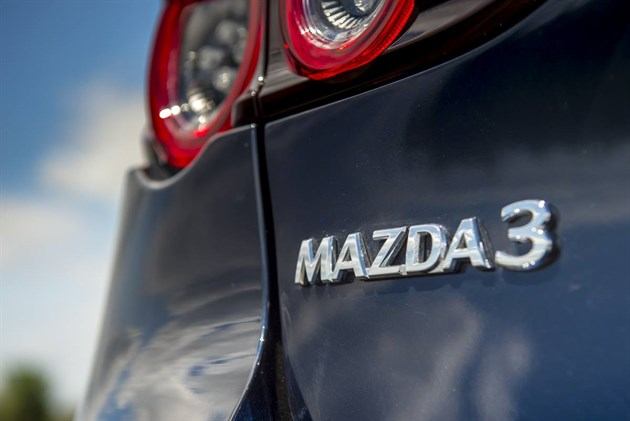
Although, thinking about it, maybe that’s a good thing. Because getting in and out of the Mazda 3 is a bit of an ordeal. It’s low and the openings are narrow, which is odd when you think about it. Do Mazda’s traditionally older customer base want a car that’s hard to get in and out of? The smart money says no.
Perhaps they’re going for the yoof market? If that’s the case they’ll need more than a GT badge. The new Mazda 3 shows no signs of sportiness in looks and thanks to the demise of the RX-8 and a lack of motorsport presence there’s a real lack of a ‘halo’ model to draw in the crowds.
The Mazda3 is certainly a well-spec’d car. Our GT Sport model includes electric door mirrors that tilt down when reversing, electrically adjustable driver’s seat with a memory function (that also includes the angles for the door mirrors). There’s even heated seats and steering wheel.
But there are some, er, unusual touches too. Like a touchscreen that isn’t a touchscreen. And an odd suspension set-up. The jury’s currently out on these features so we’ll report back on them in a couple of reports.
Mazda 3 has grand designs
Posh new interior is a big talking point for the new Mazda 3 - but is it any good?
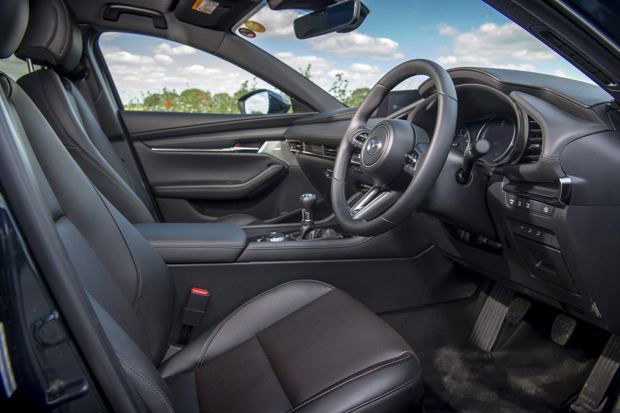
Date: 11 July 2019 | Current mileage: 1498 | Claimed economy: 44.8mpg | Actual economy: 43.3mpg
One of the big talking points of the new Mazda 3 is the interior. And it’s easy to see why – the cabin is practical, well laid out, stylish, and full of high-quality materials. In short, it’s actually a really nice place to spend your time.
Unlike too many models, the car is actually set up for right hand drive markets, so you don’t have to worry about window wipers that don’t go all the way across the windscreen, or a touch screen display that is angled away from the driver because it’s been designed for left-hand drive and the manufacturer hasn’t bothered to re-engineer the cabin.
There’s a healthy amount of buttons for the essentials, but not too many. And our multi-function steering wheel lets you control the volume, answer the phone, and adjust the cruise control. Sport models also come with chrome detailing on the steering wheel and start button, and there are nice touches like a frameless rear-view mirror.
Our GT Sport has black leather heated seats that are comfortable on long journeys – although we’d have liked to have seen more space in the footwell, which feels cramped (especially with it’s overly high clutch rest, which has the effect of putting the driver at an odd angle).

The thing we love the most about our car is the premium 12-speaker Bose surround sound system. This isn’t just for lovers of phat beatz and bangin’ tunes – it just makes everything sound better. It’s good at any volume and for any kind of music and it’s standard on this model. Other standard equipment includes a head-up display and radar cruise control.
After spending a bit of time with the car, we can report that the interior is (mostly) hard wearing and free from niggles. But the leather on our gear stick has wrinkled up over the summer and the lid of the centre console storage bin seems to stick, which can make it a nuisance when trying to retrieve your phone/wallet/whatever.
Perhaps one of the biggest letdowns is the air-con – both in terms of operation and performance. The controls aren’t positive enough so if you’re a bit too light with them you won’t actually see an increase or decrease when you rotate the dials.
Weirdly, the air-con is also a bit… weak. Generally, the hotter the country is built in, the more fierce the air-conditioning is. For example, we’ve had Hyundai’s that were cold enough to legally transport chilled goods when they were set to ‘low’. But the Mazda is generally unimpressive when it comes keeping you cool.
Mazda 3 beset by baffling niggles
For such an important car, there are some glaring faults with the new Mazda 3.
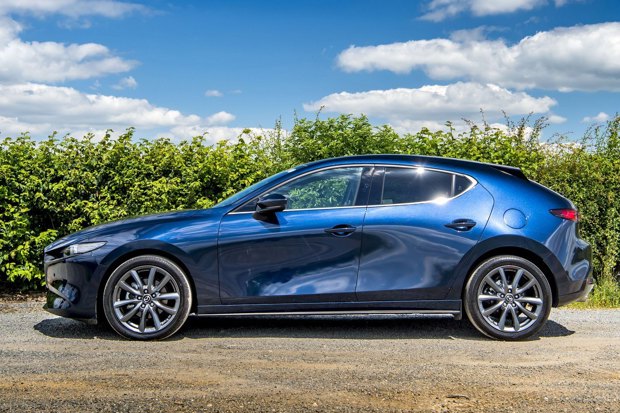
Date: 25 July 2019 | Current mileage: 1897 | Claimed economy: 44.8mpg | Actual economy: 43.3mpg
We’ve only been with our Mazda 3 a few weeks, but already we’ve noticed a frankly baffling amount of niggles that look destined to test our relationship with our latest long-termer.
First on the list of things Mazda need to sort is the keyless locking system, which works about 50% of the time. It’s a fairly self-explanatory system – and one that most manufacturers haven’t had any real problems with for the past decade or so. But for some reason, our Mazda has an entirely haphazard approach to whether it will (or won’t) lock itself.
It’s niggles like this – niggles that are so small – that drive us round the bend. Sometimes you can park the car and walk away from it, only to check back to find it hasn’t locked. Other times, you can put the kids in the back and walk round to the driver’s seat, only to find that the car has locked itself. Not only that, it refuses to open when you lightly touch the door and you have to dig around in your pocket your bag for the keys you had two seconds ago but put away because you thought you didn’t need them.
And the best bit? When you finally get in the car, the system can’t ‘see’ the key and you have to get they key out (again) and touch it to the start-stop button in order to turn the engine on. It is literally the worst getaway car. Ever.
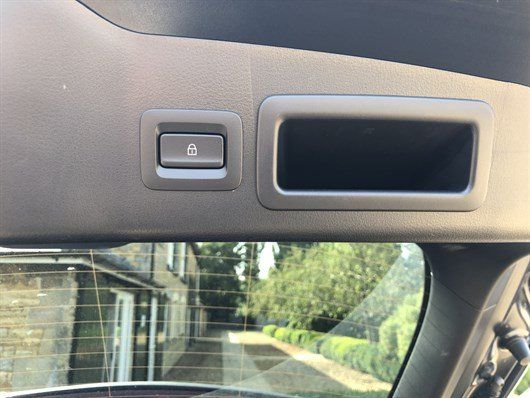
Rather than closing the boot, this button locks the whole car - with the keys in it.
In fact, the locking mechanism seems to be something of a weak spot for our car. Did you know that you can actually lock the keys in it? Well you, can – and we’ve no idea how this is even a thing. You see, the Mazda 3 has an, ahem, ‘handy’ locking button on the boot. It’s in exactly the same place most cars have the electric boot closing button, which you means you have to remind the kids not to push it every time they go to close the boot.
If you do press it, then the car will lock. This is especially handy when the keys are in it. And don’t think it doesn’t know – because it does. It locks all of the doors… apart from the boot. Thus meaning that in the middle of the Co-op car park you have to open the boot, wrestle the car seats and get the back seat down. You can then climb through to the front and retrieve your car keys from wherever you’ve stored them.
As a not-so-interesting aside, we normally stash ours in the centre armrest and getting the out from there takes five seconds – that’s exact same amount of time for the car to flash up your economy figures at the end of your journey so you always miss it.
While we’re on the subject of locks, don’t expect the internal lock/unlock mechanism to work as it’s supposed to, either. It takes three or four goes to open the doors to let a passenger out (or in) with the engine running. And most of the time you have to stop the engine to trigger the central locking mechanism to get the desire results.
If things continue like this, it's going to be a long six months.
Why doesn't the Mazda 3 have a touchscreen?
Mazda takes a step backwards in a bid to move forwards
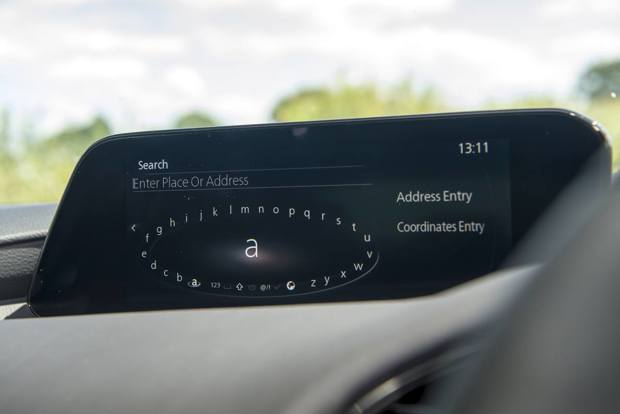
Date: 8 August 2019 | Current mileage: 1897 | Claimed economy: 44.8mpg | Actual economy: 44.1mpg
It’s a question we’ve asked ourselves on a regular basis: why doesn’t the new Mazda 3 have a touchscreen? It’s fair to say that the vast majority of new cars on sale today come with a touchscreen. But our Mazda long-termer doesn’t.
Instead, what it has is an (ahem) old school rotary dial – you turn the knob clockwise and anti-clockwise to select various points on the display and push it down to ‘click’ or select an item.
It’s hardly a ground-breaking concept. In fact, it’s remarkably similar to the very first iDrive system introduced by BMW back in 2001. And although that system was pretty badly received, it was obvious at the time that it was the best way to cope with the multitude of functions and options presented to drivers by their increasingly complicated rides.
And, let’s face it, the days of just having just heater controls, lights and windscreen wipers on the centre console are long gone. Over the past five years, manufacturers have favoured touchscreens so drivers can literally ‘point and click’ to adjust everything from how long the interior lights stay on to the car’s suspension settings.

That’s ok, if you’re stationary, but on the move it’s not ideal. There are plenty of times that we’ve gone to use our smartphone’s sat-nav only to hit a pothole and end up selecting the telephone. Yep, I know what you’re thinking – cars are too complicated. And you’re right, but it would be foolish to stall the march of progress.
We’re actually a fan of using the rotary selector dial. It’s located in the centre of four hot keys (homescreen, navigation, music, and back) and while you might have to glance down at them initially, chances are you’ll be able to remember which is which after a few days.
But it’s actually the safety aspect we appreciate the most. The dial is easily locatable and can be driven with occasional glances towards the screen – rather than the touchscreen which always requires you look where you’re jabbing your finger.
The obvious downside is that keying in place names can be a bit tedious, but the Mazda does have voice recognition while the sat-nav can handle postcodes so it really isn’t the end of the world.
Perhaps, then, the question shouldn’t be ‘why doesn’t the Mazda 3 have a touchscreen?’ but rather ‘how much am I bothered by the Mazda 3 not having a touchscreen?’ The answer to that is easy: not at all.
Half-term report. How's our Mazda 3 performing?
Three months in and we take stock of the pros and cons of Mazda 3 ownership
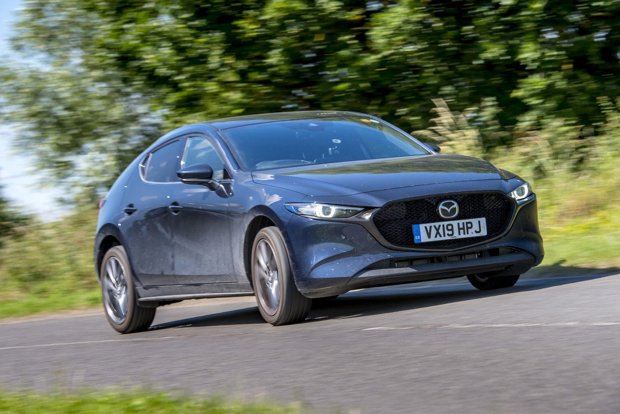
Date: 22 August 2019 | Current mileage: 2337 | Claimed economy: 44.8mpg | Actual economy: 44.9mpg
When we first drove the Mazda 3, we sang its praises. The intererior wowed us, the stereo surprised us and we reckoned it should be on anyone's list looking for a medium-sized family car. But after three months with the car, do we still rate it so highly?
Yes, and no. There's no doubt that the interior is excellent. Lots of soft-touch materials with just the right amount of buttons. We've seen the material on the gear knob wear over the summer in the heat, but it's generally held up pretty well. It's also very comfortable, and very quiet - thanks to the refinement of our 2.0-litre petrol engine.
Then there's the Bose sound system. Honestly, as someone who loves their music, having a decent stereo makes a huge difference and makes even the dullest commute bareable. The seats are supportive and the driving position is pretty decent, if a little cramped for a six-footer.
We've been pleasantly surprised by the bootspace as well. Despite not looking like much 'on paper' in the real world it's done us proud, thanks to it's logical layout and lack of intrusion from suspension components. And, for the first time in a long time, we're driving a car that is actually returning more than it's quoted MPG figure. That's not to be sniffed at.

But (there's always a but), if it was our money, we wouldn't buy one. Why? Well, there's a few reasons. The first is rear seat space. With two kids to ferry around, things get cramped in the back. And while the car's looks may be easily described as stunning all those sharp angles make getting in and out of it a total pain.
We're also beset by weird electrical issues, most pressing of which is the keyless entry system. Here, I can open the rear nearside door to help my daughter get in, shut the door and walk round to the driver's door only to find the car has locked itself and won't unlock until I put my shopping down and get the keys out. And don't even get me started on the ability to lock the keys in the car...
Then there's performance. People who've driven the more powerful models rave about the acceleration and the handling, but I wouldn't know. I've never been able to get enough power out of the 2.0-litre engine to trouble the twisty stuff.
Finally, there's the lack of a touchscreen. Not a deal breaker (and 90% of the time I actually prefer the dial) but there are times when you just want to touch the screen and be done with it, rather than use the dial to input an address. Ultimately, the Mazda 3 and I just don't seem to be well suited - but we're very confident that there are plenty of would-be Golf buyers with £25k to spend who it's perfect for.
What's the 2019 Mazda 3 like to drive?
We look at one of the Mazda 3's strong points - handling
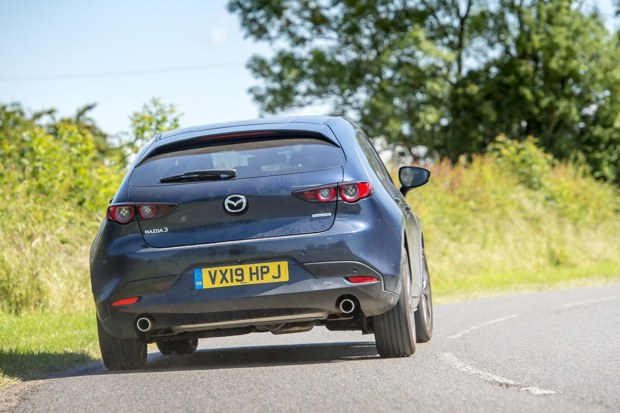
Date: 5 September 2019 | Current mileage: 2989 | Claimed economy: 44.8mpg | Actual economy: 44.9mpg
One of the best things about the 2019 Mazda 3 is its handling. While Mazda often made sure its sports cars were the sharpest knives in the drawer, the same wasn’t always true of its family cars.
Sure, the 323 was a lot of fun (especially in turbo guise) but mostly they were made to be driven by old people and cabbies. Sometimes both at the same time. In fact, it wasn’t until Ford got involved with the Mazda 6 that things got interesting.
There’s no doubt that the 2002 6 transformed Mazda’s family line up. Drawing heavily from lessons learned by its stablemate, the Ford Mondeo, Mazda gifted us a car that boasted sharp steering and brilliant braking.
But, after getting it right, Mazda lost its way. And when the financial crisis bit in 2008, Ford sold it stake and Mazda was left treading water. Thankfully, the new Mazda 3 genuinely feels like the start of a new chapter in the company’s history.

Of course, how much fun you have in your 3 will largely depend on what engine you’ve got. But even with our slightly tepid 120PS 2.0-litre petrol, we can appreciate that this is an excellent chassis that could take a lot more power.
Unusually for a Mazda engine, the power delivery is all in the mid-range. Peak torque of 213Nm is available at 4000rpm while the 122PS is there from 4000-6000rpm. I know, it took us by surprise, too – but trust us, there’s nothing after 6000rpm.
The steering is precise, while only the very poorest of roads will upset the chassis. Like its rivals, there’s not an enormous amount of steering feedback, but thankfully when the car gets out of shape it’s all very predictable and easily corrected.
Perhaps the only thing that lets down the driver experience is the brakes. Because the car is a mild hybrid, the braking system is used to help charge the battery. That means it takes a long time to get used to because the first part of the pedal’s travel doesn’t seem to have any effect. If you’re pressing on, you’ll need to be quite heavy footed to get the best out of the stoppers.
Why the Mazda 3 is more comfortable than my house
We sample the peace and quiet afforded by the new 3's interior

Date: 19 September 2019 | Current mileage: 3543 | Claimed economy: 44.8mpg | Actual economy: 44.9mpg
We’ve spent a fair bit of time with our Mazda 3 long-termer, and there’s one thing that wins us over every time – the quality of the interior. It’s full of high-quality soft-touch materials, there’s decent size centre-screen, and it’s well-insulated from road noise. In fact, it's actually more comfortable than my house.
It doesn’t matter how long the journey is, you’ll always arrive refreshed. That’s because the driver’s seat is comfortable but supportive, with extra attention paid to the side bolster. It’s easy to find a good driving position – although it is let down a bit by having a oddly angled clutch rest.
The set-up for the driver is also (mostly excellent), especially at night. The dials you need the most are illuminated the brightest while the other controls are slightly dimmer. You’re also not overwhelmed by buttons, with just the important stuff in place. That said, we still don’t know why you’d need to display two fuel gauges… especially when they both read slightly differently.
We’ve covered the lack of a touchscreen in detail, but on the whole the Mazda 3’s infotainment system is excellent. For a start, it’s quick – you have almost instant access to the navigation software after the car is started so there’s no waiting around for it to load. There’s also a 3D gryo sensor that calculates the vehicle’s position in areas of low coverage.
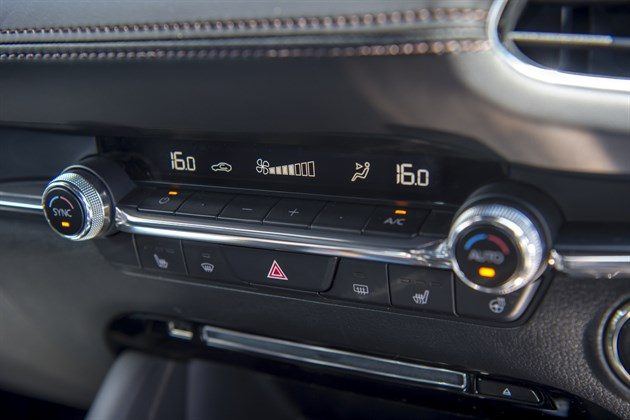
The rotary dial is easy to control and a Google-style ‘one box’ predictive search takes some of the hassle out of destination inputs. You can also use voice control to speak your destination, but you’ll either have to wait for the nav to start automatically or go into safe-cracking mode as you spin the dial to confirm your destination.
Almost of all of the controls in the new Mazda 3 are positive and user friendly. For example, the volume control on the centre console not only rotates clockwise and anti-clockwise, but can also be nudged if you need to skip a song.
This control is repeated on the steering wheel, but in a slightly different format. Here you have horizontal switch to control volume, while a separate button on top or below handles the track skipping. Our only grumble is the temperature control dial, which is easy to turn but doesn’t always result in action.
Like all of the controls, it’s easy to identify by touch so minimises the time you need to take you eyes of the road (which is also the thinking behind the rotary dial) – and we’re big fans of that ethos. Mazda has also redsigned the A-pillar to improve visibility while washer jets on the wipers increase their effectiveness and reduce the amount of time the screen is smeared.
Let's talk about engines
We're longing for the return of the Mazda 3 SkyActiv-D diesel...

Date: 17 October 2019 | Current mileage: 4201 | Claimed economy: 44.8mpg | Actual economy: 44.9mpg
Ever since I drove the latest Mazda 3 home from its UK launch in Scotland earlier this year, I’ve been a huge fan. I said that its interior was "up there with the best", it's "as good to drive as the new Ford Focus", and that overlooking the Mazda 3 would be a "huge oversight".
So it’s been disappointing to hear Keith’s weary sigh every time I ask him how he’s getting on with his long-termer. How can he not being enjoying his time with the Mazda 3? It’s one of the most attractive cars in its class, while the interior is simply superb. His GT Sport model even has the incredible Bose audio system.
Last week, I headed to Yorkshire for a drive of the Mazda 3 with its clever new Skyactiv-X engine. This is a petrol engine with diesel technology, said to combine the benefits of both. Mazda’s so confident that it’ll do the job of a diesel with none of the drawbacks, it’s taken the diesel off sale.
And that’s a disappointment. When we first drove the Mazda 3, we said the 1.8-litre Skyactiv-D diesel was the best engine for the 3. And I stand by that.
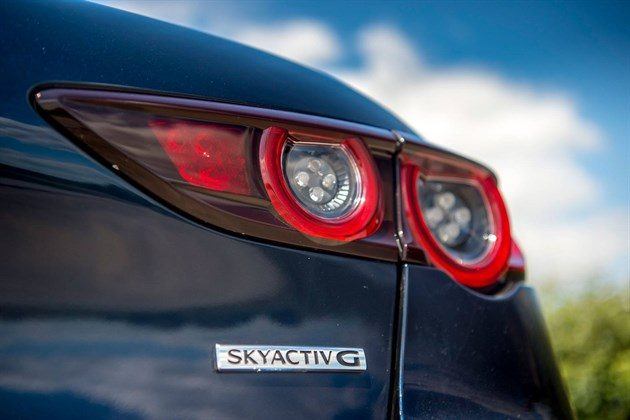
No, a diesel doesn’t suit everyone. If most of your journeys are fairly short or you regularly drive in town centres, a petrol is the engine for you. But this is the kind of car that’ll be popular with company car drivers who trudge up and down motorways for tens of thousands of miles a year. A diesel still makes sense. And what a brilliant engine that 1.8-litre diesel was. Surprisingly eager to the revved, while fuel economy was impressive (55.4mpg officially) and refinement was excellent - particularly on the motorway.
We could forgive Mazda if the new Skyactiv-X engine was at groundbreaking as is being made out. But it’s not. It’s not as refined as the entry-level Skyactiv-G petrol engine, while fuel economy on our early drive suggests it just isn’t as efficient as a diesel. We might be proved wrong when we’ve spent some more time on the motorway - admittedly, our test route through the Yorkshire Dales was more about enjoying the 3’s excellent handling rather than achieving incredible fuel economy.
It seems bizarre that Mazda’s decided that offering a diesel engine is too much of a niche, but there’s a market for saloon and four-wheel-drive models. Who’s asking for them?!
The good news is that the diesel engine is still being fitted to the 3 elsewhere in the world. It’s been a decision within Europe not to bring it to the UK any more so it’d be pretty easy to reverse than decision once Mazda’s realised there’s still demand for diesel. We’ll keep our fingers crossed.
Andrew Brady
Which is the best Mazda 3 - saloon or hatch?
Keith reckons the Mazda saloon is a winner.
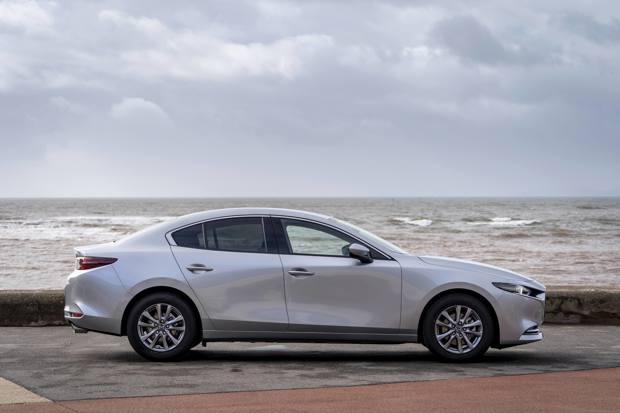
Date: 13 November 2019 | Current mileage: n/a | Claimed economy: 50.4mpg | Actual economy: 50.4mpg
We’ve always had a bit of a soft spot for a Mazda 3 saloon. Ever since the first generation, we’ve admired its baby BMW looks that made it prettier – not to mention more practical – than its hatchback sibling.
Now we’ve had a chance to drive both the hatch and the saloon varients of the latest incarnation, we’re just as convinced that it’s the saloon that makes decent sense as a family car. For a start there’s the more rounded looks (with the rear overhang balancing off the car’s long bonnet) which make it easier on the eye than the hatch.
But while the Mazda 3 has lost a inch or two of rear legroom with the latest generation, it feels like it’s regained a little bit of that with the saloon thanks to an extra 3mm shoulder room. And while it might not sound like much, if you’re a taller driver with rapidly growing kids, then you’ll know how nice it is not to be kneed in the back.
That said, the saloon does retain the car’s greatest design flaw – getting in the back is a total pain thanks to the sharply styled lines. Brace yourself for bumps and scrapes of varying degrees. Heaven forbid a designer should place passenger comfort above penmanship…
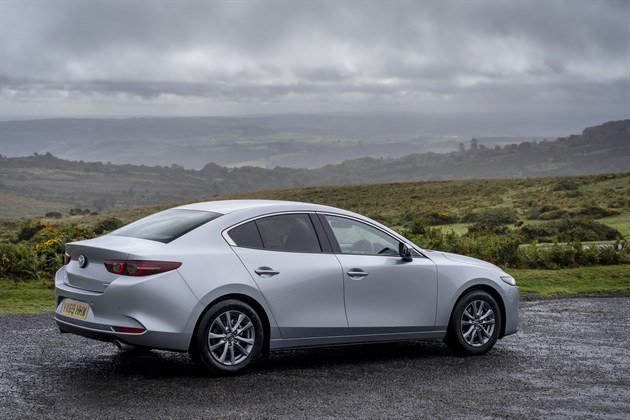
As a family car, the saloon makes a lot of sense. For a start, there’s more bootspace – 444 litres compared to 351 in the hatch. In fact, the hatch is hardly best in class, and definitely lacking behind rivals like the Ford Focus or the Volkswagen Golf.
Of course, whether this is good for you depends on how you’re planning to use it. Neither car is particularly easy to load in and out of, but the saloon’s bootspace is more usable (unless you’ve got a dog guard fitted to stop stuff in the rear of the hatch hitting people in the head). That said, if you’re loading a travel system (aka pram) in and out you may prefer the hatch.
Most people reject saloons on more simple grounds, though. With manufacturers refusing to fit rear wiper blades on the saloon, visibility can be an issue (in a car that definitely feels claustrophobic and lacks glass, this isn’t great). On paper, cas makers say the aerodynamics take car of clearing the rear screen – but as these don’t kick in until you’re out of town, we’ve never been happy with that explanation.
As far as pricing goes, the Skyactiv-X hatchback starts at £23,370 on the road, while the saloon is £23,555. At the end of the day, we’d be happy to pay the difference and drive home the saloon.
Is the all-wheel drive system on the Mazda 3 any good?
We get to grips with Mazda's new all-wheel drive system for the its 3 hatchback.
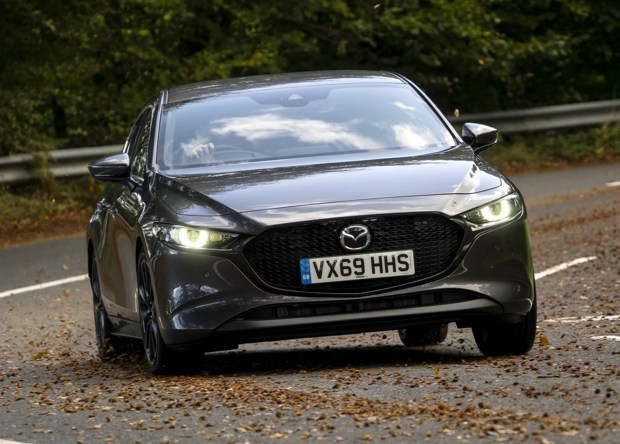
Date: 31 October 2019 | Current mileage: n/a | Claimed economy: 45.6mpg | Actual economy: 48.9mpg
Over the past couple of weeks, we’ve been lucky enough to try a couple of different flavours of our Mazda 3 long-termer that showcase Mazda’s latest 180PS Skyactiv-X engine, which we drove a few weeks ago.
First up is the all-wheel drive hatchback. Essentially it’s the same as our long-termer in terms of spec, but the driving experience is world’s apart. While we had an inkling that the chassis might be quite handy in our 3, mating it to this engine and drive train makes a big difference.
As you might expect, there’s significantly more grip thanks to drive going to all four wheels. It’s not a full-time system and only kicks in when you need it, which means that fuel economy isn’t damaged too much (despite the car weighing an extra 45kg).
In engineering terms, it’s a fairly typical system with a driveshaft going to the rear and a clutch pack used to engage the backwheels. A maximum of 50% of the engine’s torque can be sent to the rear… but while the hardware is standard the software that controls it certainly isn't.
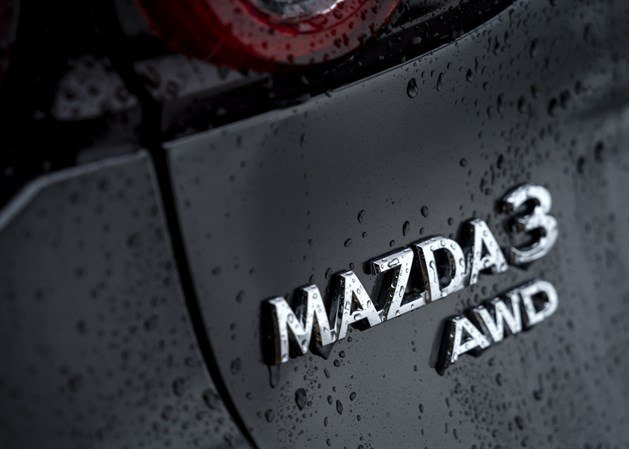
While most systems are reactive and wait until a wheel starts to slip before adjusting driven wheels, Mazda’s system uses an array of sensors across the car to prevent tyres losing grip. The software looks at steering inputs, the pitch of the road, G-sensors, and yaw-sensors to predict where grip will be needed keep the car on the right track.
Essentially, the engine, transmission and G-vectoring control all work together. Accelerate hard and more torque is sent rearwards as the car squats, while it’s the opposite under braking. Turn in and the system will reduce the power sent to the front wheels so they can get on with the important business of steering while torque is held steady at the rear.
Does it work? Absolutely. And it’s not the sort of system that will shut you down either. If you want safety, you got it. But if you want to push hard and edge the rear out, it’ll do that too.
While this might not mean much to most drivers (apart from the fact they’ll be able to cope with the very worst of the UK’s weather), it actually means you can get the best out of the Mazda 3. After driving the AWD for a week, the chassis and steering improvements make it feel like a different – and much better – car.
